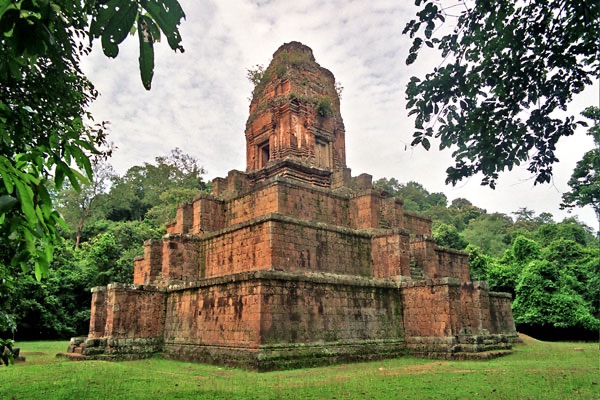Baksei Chamkrong is a towering temple located near the ancient city of Angkor in Cambodia. It stands as a testament to the architectural prowess of the Khmer Empire. Built in the 10th century, it is one of the earliest temples to use the temple-mountain architecture, which symbolizes Mount Meru, the home of the gods in Hindu mythology. Dedicated to Lord Shiva, it was constructed by King Harshavarman I and later completed by Rajendravarman II. The name Baksei Chamkrong means “The Bird Who Shelters Under Its Wings” and comes from a legend involving a large bird providing shelter to the king during a battle.
Get your dose of History via Email
Historical Background of Baksei Chamkrong
The discovery of Baksei Chamkrong dates back to the 19th century when French explorers began extensive research in the Angkor region. It was one of the many temples rediscovered by the French during their exploration of the area. The temple was built by King Harshavarman I in the early 10th century. However, it was left incomplete upon his death. His son, King Rajendravarman II, completed the temple in 948 AD.
Baksei Chamkrong was not just a religious site but also a political symbol. It demonstrated the power and religious devotion of the Khmer rulers. The temple has stood the test of time and has witnessed the rise and fall of the Khmer Empire. It has remained relatively intact, escaping the widespread destruction that affected many other Angkorian temples.
While the temple was not inhabited, it served as a significant religious site for the Khmer people. It was dedicated to the Hindu god Shiva, and it likely played a role in the religious life of the Khmer royalty and the local population. The temple’s architecture and inscriptions provide insights into the religious practices of the time.
Baksei Chamkrong’s historical importance also lies in its architectural style. It predates the famous Angkor Wat and is an early example of the use of sandstone as a building material in Khmer temple architecture. This innovation set the stage for future Khmer temples, including the iconic Angkor Wat.
The temple has not been the scene of any known historical battles or events since its construction. However, its survival through centuries of history and its continued presence near the seat of the ancient Khmer Empire make it an important link to Cambodia’s past.
About Baksei Chamkrong
Baksei Chamkrong is a small but significant Hindu temple located within the Angkor Archaeological Park. It is a classic example of the Khmer temple-mountain architectural style, which represents Mount Meru. The temple is built primarily of sandstone, a material that later became common in Khmer architecture.
The temple’s pyramid shape consists of four tiers, leading to a central sanctuary at the top. This design is a precursor to the more elaborate temple-mountains that followed. The sanctuary once housed a sacred linga, symbolizing the Hindu god Shiva, to whom the temple is dedicated.
One of the architectural highlights of Baksei Chamkrong is its intricately carved lintels and door frames. The carvings depict scenes from Hindu mythology, including the churning of the ocean of milk, a story about the quest for the elixir of immortality. These carvings are fine examples of early Angkorian art and craftsmanship.
The temple’s construction techniques were advanced for its time. The builders used a combination of laterite and sandstone, with sandstone primarily used for visible elements like doorways, windows, and carvings. The use of laterite allowed for the massive structure to be built quickly and efficiently.
Despite its small size, Baksei Chamkrong’s architectural significance is immense. It marks a transitional period in Khmer architecture, from the use of brick and laterite to the more extensive use of sandstone. It also showcases the development of the temple-mountain concept that would dominate Khmer architecture for centuries.
Theories and Interpretations
Several theories and interpretations surround Baksei Chamkrong. Scholars believe that the temple served as a prototype for future temple-mountains in the Khmer Empire. Its design and construction methods influenced later temples, including Angkor Wat.
The temple’s dedication to Shiva suggests that it played a significant role in Hindu worship. However, the exact nature of the rituals performed here is subject to interpretation. Inscriptions and carvings provide some clues, but much of the temple’s religious significance remains a mystery.
There are also theories about the temple’s name, which translates to “The Bird Who Shelters Under Its Wings.” Some suggest that this name is linked to a legend in which a king was protected by a giant bird during a battle. This legend may symbolize the protective power of the gods over the Khmer rulers.
Archaeologists have used various methods to date the temple, including inscriptions and architectural styles. These methods have helped establish the temple’s construction in the 10th century, during the reign of King Harshavarman I and his son, Rajendravarman II.
While there is no mystery about the temple’s builders, the reasons for its construction and the specific rituals associated with it are less clear. Scholars continue to study Baksei Chamkrong to gain a better understanding of its role in the religious and political life of the Khmer Empire.
At a glance
- Country: Cambodia
- Civilization: Khmer Empire
- Age: 10th century AD

